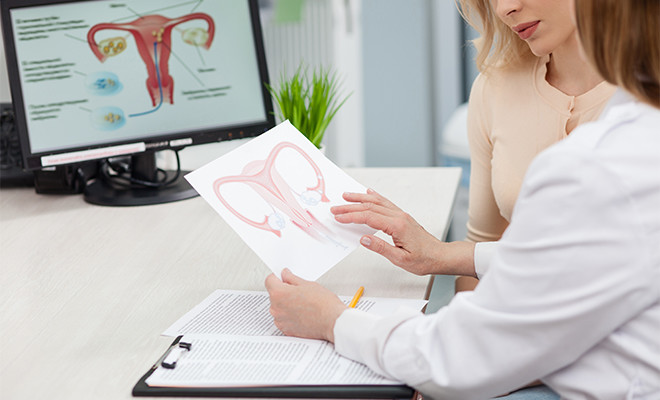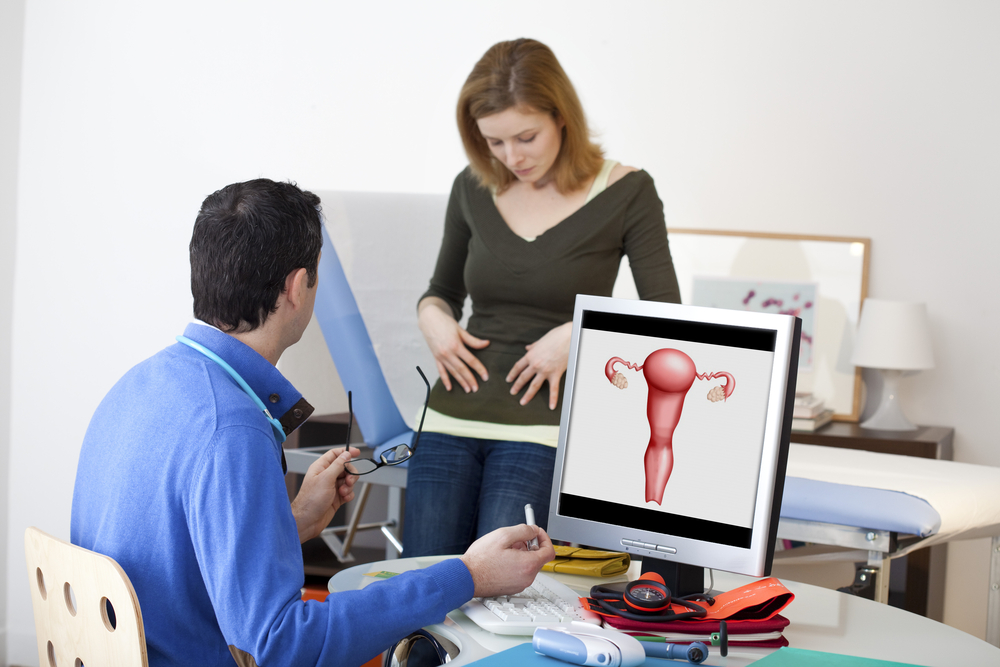We will find out how to determine infertility in women. This diagnosis is made to a woman if pregnancy does not occur within 1 year or more with the regularity of sexual relations without the use of preservatives. Absolute infertility is diagnosed if a woman has irreversible anatomical disorders that make conception impossible (lack of fallopian tubes, uterus, ovaries). With relative infertility, treatment is performed and reproductive function is restored.

Primary infertility is also distinguished, which is characterized by the absence of pregnancies in the woman's history and secondary - the impossibility of the onset of repeated conception. Infertility occurs in 10-15% of couples. Of these, male infertility is observed in about 40% of cases, and female in the remaining 60%.
Causes of Female Infertility
To understand how to determine infertility in women, we will examine the causes of pathology. The main provoking factor may be a violation of physical health. Infertility can also lead to social, family and mental problems of women. To select a treatment tactic, it is necessary to determine the exact causes that caused it.
The most common factors of infertility in married women include:
- increased secretion of prolactin;
- pituitary tumor;
- various forms of menstrual irregularities (oligomenorrhea, amenorrhea, etc.), provoked by a violation of the hormonal background;
- congenital anatomical defects of the genitals;
- endometriosis;
- bilateral obstruction of the fallopian tubes;
- adhesive processes in the pelvic area;
- acquired genital malformations;
- common autoimmune pathologies;
- tuberculous damage to the reproductive organs;
- psychosexual disorders;
- negative postcoital test results;
- unclear reasons.
Degree of infertility
In medicine, there are three degrees of infertility in women. Primary (1st degree) is characterized by the fact that a woman never has a pregnancy. What does infertility of the 2nd degree mean? The woman in this case had previously been pregnant, and repeated attempts to conceive were unsuccessful. Infertility of the 3rd degree can be said to be a kind of absolute second, but doctors usually do not use such a diagnosis. It is understood that a woman forever loses the ability to procreate.

Varieties
The forms of infertility in women are also classified:
- endocrine (hormonal);
- tubal peritoneal;
- uterine;
- infertility against the background of the development of endometriosis;
- immune
- infertility of unknown etiology.
We describe each.
Endocrine infertility
The endocrine form of female infertility is caused by violations of the hormonal regulation of the cycle, which provides ovulation. This form is characterized by anovulation due to insufficient maturation of the egg or its absence from the follicle. This is often due to injuries or pathologies of the hypothalamic-pituitary region, excessive secretion of prolactin, polycystic ovaries, progesterone deficiency, inflammatory and tumor formations of the ovaries.

Tubal infertility
This form develops in cases where there are anatomical obstacles along the path of the egg moving through the fallopian tubes into the uterus, i.e., both tubes are impassable or absent. With peritoneal infertility, an obstacle arises not in the tubes themselves, but between them and the ovaries. The tube-peritoneal type usually occurs as a result of adhesions or after atrophy of the cilia located inside the tube and providing the movement of the egg. Reproductive system surgery can lead to commissures in the fallopian tubes.
Uterine infertility
This form of pathology is caused by anatomical (acquired or congenital) uterine abnormalities. Birth defects are its underdevelopment, doubling, saddle shape or the presence of an intrauterine septum. Acquired defects of the uterus are its cicatricial deformity, intrauterine synechia or tumor. Acquired anomalies develop as a result of surgical interventions, for example, after an abortion.

Infertility in endometriosis: how is it manifested and why does it occur?
Infertility often provokes endometriosis in women (symptoms and treatment are determined by the doctor). Such a pathology is diagnosed in approximately 30% of the fair sex. The main signs: heavy menstruation, pain, discomfort during intercourse.
The mechanism of the effect of this disease on infertility is still not fully understood, but it can be reliably said that the areas of endometriosis in the ovaries and tubes interfere with the normal course of ovulation and the movement of the egg through the tubes. Symptoms and treatment of endometriosis in women are interrelated. How to treat this form of infertility, we will describe below.
Immune infertility
The development of the immune form of this pathology is associated with the presence of antisperm antibodies in the body, a specific immunity that is produced against the embryo or sperm. In about half the cases, such infertility is provoked not by a single factor, but by a complex of several reasons. In some cases, they remain unidentified even after a thorough diagnosis.

Female Infertility Test
There are many different methods for determining infertility in women. However, these are not such tests that can determine the presence of pregnancy at home. A similar type of infertility test can be performed by men to establish sperm motility and quality. As for women, they are advised to conduct laboratory and instrumental tests.
So, how to determine infertility in women? The simplest and most affordable way to indirectly confirm the pathology is an ovulation test, which can also be done at home. This technique is similar to express methods of pregnancy confirmation. In this case, a special strip is placed in the urine. Before the egg leaves the follicle, an increase in LH occurs, to which such a test responds. If it is impossible to get pregnant, the tests are usually negative.

Such a check for infertility in women is used only if there is a suspicion of an endocrine type of ailment. In other cases, ovulation can occur, but pregnancy does not occur for other reasons, for example, if the egg does not pass through the fallopian tube due to its obstruction.
Clinical recommendations for female infertility
The issue of infertility therapy is decided by the doctor after evaluating the results of all diagnostic examinations and establishing the exact causes that caused it. Treatment usually begins with the elimination of the original cause. The techniques used in this case are aimed at:
- to restore the reproductive functions of the patient by surgical or conservative methods;
- the use of assistive technologies in cases when conception in a natural way is impossible.
With the endocrine form of pathology, hormonal disorder and ovarian stimulation are corrected. Among non-pharmacological types of correction include normalization of weight (with obesity) through diet therapy and increase physical activity, physiotherapy.
Endocrine Infertility Therapy
The main type of drug therapy for the diagnosis of infertility in women of the endocrine type is hormonal treatment. The process of follicular maturation is monitored by ultrasound monitoring and monitoring the content of hormones in the blood. With an adequate selection of hormonal medicines, 70-80% of patients with this form of infertility become pregnant.
Elimination of tubal-peritoneal form of pathology
In the tubal-peritoneal form of the disease, the goal of treatment is to restore normal patency of the fallopian tubes using laparoscopy. The effectiveness of this method is approximately 30-40%. With prolonged adhesive obstruction or with the ineffectiveness of a previous operation, the implementation of artificial insemination is recommended.
Treatment of the uterine form of the disease
In cases of the development of the uterine form of female infertility and the presence of its anatomical defects, reconstructive plastic surgery is performed. Pregnancy occurs in approximately 15-20% of cases. If it is impossible to promptly correct the uterine form of infertility and carry the child on their own, they resort to the services of a surrogate mother.
How to treat infertility with endometriosis?
Infertility, which is caused by endometriosis, is treated with laparoscopic endocoagulation, during which pathological foci are removed. The result of surgical treatment is fixed by the course of taking medications. The probability of pregnancy after this is about 30-40%.

Immune infertility: how to fight?
In immunological infertility, in most cases, artificial insemination through artificial insemination is performed. This technique allows you to overcome the immune barrier of the cervix and in 40% of cases contributes to the onset of conception.
Treatment of unexplained forms of infertility in women
Therapy of unidentified forms of this pathology is a very complex problem. In these cases, most often resort to the use of assistive techniques of reproductive technology. In addition, indications for IVF are:
- lack of fallopian tubes or tubal obstruction;
- condition after conservative therapy and laparoscopy regarding the elimination of endometriosis;
- absolute infertility of the sexual partner;
- depletion of ovarian function;
- unsuccessful therapy of endocrine forms of infertility;
- concomitant pathologies in which pregnancy is impossible;
- some cases of uterine infertility.
Methods of artificial insemination
The main methods of artificial insemination are:
- Intrauterine insemination with the sperm of a partner or donor.
- Intracellular injection of sperm into the egg.
- Surrogacy.
- In vitro fertilization.
- Use of a donor embryo or donor egg.
The age of the spouses affects the effectiveness of infertility therapy, especially for a woman (after 37 years, the probability of successful conception is sharply reduced). Therefore, it is necessary to start the treatment of this pathology as soon as possible, which significantly increases the chances of having healthy offspring and allows you to get by with minimal drug costs. It should be remembered that surgical methods of treatment are used only in extreme cases and many forms of the disease can be treated with conservative methods.
We examined how to determine infertility in women.